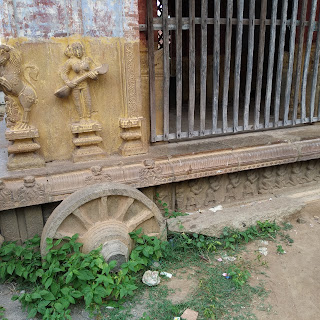Ancient
temples in Bharat, in the southern regions of magnificent country, are evidence
of the high levels of artistry, spirituality and science which mark or history.
The spirituality and religious fervour of the Hindu kings that ruled was the
reason why we have these gopurams, sculptures, carvings with thousand pillared
halls. These structures stand today and inspires us as it did our saints and
poets who sang their praises.
On
a two-day historical tour to Thanjavur, Mannargudi and Mahadevapattinam with
Mystic Palmyra, conducted by historian Pradeep Chakravarthy, I was filled with
gratitude and wonder. Gratitude that I could see a thousand-year-old
Brihadeeswara temple today and wonder at the passion and devotion behind the
vision. As a schoolgirl, skipping behind my father, then as a Bharata Natyam
dancer, later as a patron of Bhagavata mela, and now as an author of a book on
Thanjavur, I have made over twenty trips here and every time, this temple never
fails to impresses me with a different perspective. In this blog I will share
information some of which I had only read about and never seen, and some I was
not aware.
According
to my calendar, Raja Raja Cholan’s birth anniversary falls on October 20. (947-
1014 CE) So many legends surround this temple. The Nayaks and the Marathas
enhanced the structure and today we see a temple complex with generous
contributions from all of them. The front gopuram is built by the Marathas, as
is the temple for Vinayaka. A Vinayaka idol consecrated by Raja Raja is seen in
a small shrine behind the temple.
It
was thrilling to be in the temple that day as it was Pradosham. We were allowed
into the garbha graham for darshanam, thrilled to be within two feet of the
Siva Lingam during archana. Unforgettable moments.
Thanjavur Palace , Durbar Hall, art Museum and the Library were mandatory visits.
The
evening procession of the Utsava murti around the temple was accompanied by
drums. We stayed back till 8.30 that night for Palli Arai Sevai. This is the
last rite of the day when Siva enters the bedchamber of Devi. After Devi’s
aarathi is done, She is taken inside the bedchamber in a palanquin and the
doors close instantly. It is all over in minutes but what a beautiful
experience.
Mannargudi
Rajagopalaswami temple is vast. Again, we had excellent darshanam. An extra
bonus was to be able to hold the golden infant Krishna for a second and pray
for a fulfilment of a desire. The priest joked that as in real life, you gift a
small amount when you visit a new-born, here too, that we must gift the infant
some currency, which we all gladly did.
A many pillared hall inside the temple.
A
Tulsi Brindavan inside had carvings and stood on a tortoise pedestal. Elephant
heads were seen around the lower level.
Mahadevapattinam
was an eye opener. We visited Raja Gori, the memorial shrines of Maratha Kings.
They are cremated here, and a shrine is built in that location.
A Siva Lingam
is installed for kings and a Devi idol is built for the queens. There were a
few dilapidated shrines scattered around the place.
My
heart bled to see the state of these shrines which were not only important for
history, but also a tribute to the lion-hearted Marathas. We do not know whom
the shrines belonged. Pradeep pointed out the specially manufactured bricks
which were thinner than the conventional one. The structures were made of brick,
stucco and lime. Tourists are not aware of this place and therefore there is no
maintenance.
The
last Maratha King Shivaji II (1855) had a better shrine.
The
fort and Varaha temple built by Tulaja I who wrote the yakshaganam Sivakama
Sundari Parinaya Natakam is situated here. No one visits here
anymore. Many structures were gone and in its place is a coconut orchard.
Tulaja's temple for Sri Varaha.
The
Maratha Rajas were devoted to both Siva and Vishnu. They worshipped both and
that is how Tulaja built the Varaha temple. It is very small, and the idol is
also about three feet only. It is in ruins now, though a priest was at the
shrine and performed aarathi. The walls of the fort still exist.
A
slab of stone with carvings on one side and an inscription on the other continues
to be part of the daily worship.
We
proceeded to Orathanadu where one of the many chathrams built by the Marathas
still exist. I have read about the chathrams, written about them but I never in
my wildest dream imagined I would actually be able to visit the Muktambal
Chathram.
These
Chathrams are rest houses for pilgrims and doubles as a school and medical
facility when required. Food was served to the tired pilgrims who would then
proceed on their journey when they wanted to. Serfoji built this Chathram for
his queen in the form of a chariot.
It has beautiful carvings on the walls, and
we can see the wheels (though half submerged in the ground), the elephants and
the charioteers. It is in a state of sheer neglect. Why can the authorities not
clean the premises and clear the bushes around it?
One trip some of us
missed (because of traffic regulations) was the visit to the largest iron canon
in the world, which has not rusted or deteriorated after centuries.
It
was a trip well worth it for me as it is relevant to my current interest in the history
of Maratha Kings. Efficiently organised by Priya Thiagarajan, and with a bus full of
friendly, knowledgeable and enthusiastic guests, a tour with Pradeep is a must
for all those who seriously want to learn about our heritage.
Photos
by the author.
#MysticPalmyra,
#PradeepCharavarthy, #PriyaThiagarajan, #ThanjavurACulturalHistory











No comments:
Post a Comment